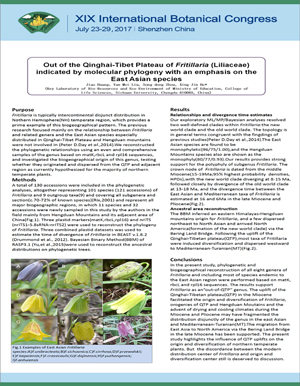NEWS 2017
Out of the Qinghai-Tibet Plateau of Fritillaria (Liliaceae) indicated by molecular phylogeny with an emphasis on the East Asian species
Jiao HUANG, Yan-Mei LIU, Song-Dong ZHOU, Xing-Jin HO
POSTER-P0182, XIX Internetational Botanical Congress, Shenzhen Convention & Exhibition Center, 23-29 July 2017
http://www.fritillariaicones.com/info/news/news_2017/Huang_et_al_2017_poster.jpg
Key Laboratory of Bio-resources and Eco-Environment of Ministry of Education, College of Life Science, Sichuan University, Chengdu 610065, China
Abstract
The East Asian region is considered the cradle for many cosmopolitan plants and the uplifts of the Qinghai-Tibetan Plateau (QTP) in this region have played a key role in driving diversification and dispersal of numerous northern temperate plants. The hypothesis “out-of-QTP” suggests that the majority of northern temperate plants have originated and dispersed from the QTP and adjacent region. An interesting question is whether the biogeographic history of Fritillaria, widely distributed in the northern temperate region, coincides with the hypothesis “out-of-QTP”? In the present study, phylogenetic and biogeographical reconstruction of all eight genera of Fritillaria and including most of species endemic to the East Asian region were performed based on ITS, matK, rbcL and rpl16 sequences. The results support Fritillaria as an “out-of-QTP” genus. The uplift of the QTP in the Miocene facilitated the origin and diversification of Fritillaria, orogenies of QTP and Hengduan Moutains and the advent of drying and cooling climates during the Miocene and Pliocene may have fragmented the distribution disjunctly of the genus in the East Asian and Mediterranean-Turanian (MT). The migration from East Asia to North America via the Bering Land Bridge in the late Miocene has been supported. The present study highlights the influence of QTP uplifts on the origin and diversification of northern temperate plants.




